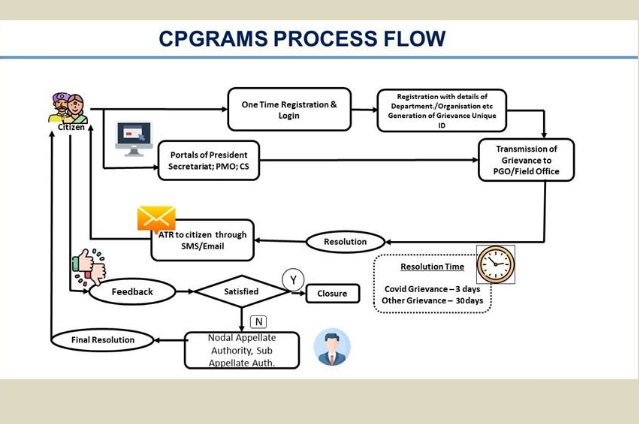INTRODUCTION

Corruption is the enemy of development and good governance. It must be got rid of. Both the government and the people at large must come together to achieve this national objective.
~ Pratibha Devi Singh Patil
As we know India has a unique federal structure which is called a 'Quasi federal structure'. The 7th Schedule of the Indian Constitution divides the functions between the Union and the states, which distinctively proves its federal structure. To run the politico-administrative structure of the country there is an elected government which is directly elected by the people of India in the form of Member of Parliament. Thereafter the majority party makes the government and forms the government at the centre; sworn by the president of India to the head of the government, 'The Prime Minister'.
To perform multifarious functions in the country the whole government has been divided into various ministries and departments. Administration is the tool that is used by the government to run the system in the country; to run the same administrative system, bureaucracy plays the most significant role in it. Bureaucracy is considered the Steel frame of the country. Why so? As it was/is a bureaucracy that manages and implements all the programs/schemes/laws. Bureaucracy or public officials have a great responsibility. While performing all the administrative functions innumerable glitches come in the path. Sometimes those obstructions become such a great hindrance in the way that it takes a lot of effort to remove and consequently causes inefficiency and ineffectiveness in the work performance. And those hindrances are contemplated in the form of public grievances. This term public grievance entails corruption, red-tapism, technical fault in the mechanism, tussle between the general public and government officials, and so on. Thus, the government brought so many reforms to it. As we know, however, it is the time of good governance with the aid of e-governance. Government machinery endeavored to lay down its efforts to redress the issues.
Amongst various ways to dissolve public grievances, there is a unique way that has been, nowadays extremely popularized in the public view and that is CPGRAMS which is directly concerned with e-governance.
WHAT IS CPGRAMS?
Centralized Public Grievance Redress and Monitoring System which is abbreviated as CPGRAMS. It is an exemplary model of e-governance. It is facilitated by the Department of Administrative Reforms and Public Grievance on the website pg.gov.in. It is a 24×7 facility where anyone can register his or her complaints which is unsolved despite putting in the effort. It was initiated in 2007 but its establishment happened in 2008. It was developed by the National Informatics Centre(NIC), in amalgamation with the Director of Public Grievances(DPG), Department of Administrative Reforms and Public Grievances(DARPG). CPGRAMS was launched by the Department of Administrative Reforms and Public Grievance under the Ministry of Personnel, Public Grievances, and Pensions.
OBJECTIVE OF CPGRAMS
Redressal of public grievances is a significant point of discussion because if the matters are not resolved then what is the point in launching the new schemes for the well-being of the people? Thus, it has some objectives and to fulfill them, its functions and those objectives are mentioned below:
- Reduction in the time consuming to dissolve the grievance
- Monitoring the grievances of the public
- Exercise control over the different issues of the staff and line agencies like corruption and red-taps.
ISSUES THAT ARE OUTSIDE ITS JURISDICTION
CPGRAMS has some restrictions as well there are some areas that cannot be entertained under this program and those are mentioned below:
- RTI Matters
- Court-related / Subjudiced matters
- Religious matters
- Suggestions
- Grievances of Government employees regarding their service matters including disciplinary proceedings etc.
PROCEDURE TO LODGE THE FILE
Several steps are taken to lodge the complaint on the platform of CPGRAMS and if we try to understand it casually then we won't be able to get it entirely in a good manner. Thus, let's strive to comprehend it by dividing it into various steps in the following manner:
Step 1: If there is someone who has some problems relating to any public organization or Public Enterprise or Public Sector Undertaking then first of all he/she will file a complaint to the highest official of the office or organization. If the grievance is solved then it's OK and if it's not solved then come on the online platform pg.gov.in.

Step 2: Registration on the online portal and fill in the real and factual information like Name, Address, Email ID, and Mobile Number, Select the organization or the Department and attach the pdf of the previous complaint files of the concerned organization.
Step 3: Then the complaint is despatched to the Public Grievance Officer or Nodal officer of the concerned Ministry/Department/State/UT governments.
Step 4: In this step, if the redressal of the complaint is satisfying then the matter is closed. However, if the matter felt unsatisfying then one can move on to the next step.
Step 5: Once the result of the redressal has come out and if the rating is poor then there is the possibility to re-open the matter.
Step 6: If the redressal is not satisfying then the issue can be filed by the aggrieved person to the Director of Public Grievance either the post on the permanent official address with all the previous documents of the concerned matter or the online mode on dpg.gov.in.
Step 7: The Director of Public Grievance(DPG) then will take the matter into its cognizance and send directly the grievance to the concerned organization or Department to take action on it. This will be done within 15 days.
Step 8: Within 30 days, it is supposed from the concerned organization to solve the matter and give a response to DPG.
Step 9: DPG will inform the aggrieved person of all the latest updates and the satisfying result of the redressal to the person.
To ensure the fair and proper conduct of redressal of the complaint the DPG can seek for the procedure which was followed to solve the issue.
FUNCTIONING OF CPGRAMS
What does CPGRAMS do? What is the functioning of the CPGRAMS can be seen through the following points:
- It provides the facility to lodge grievances about various organizations that come in the jurisdiction of CPGRAMS from any geographical location of India.
- Having filled out the complaint, the aggrieved person can see how many complaints have been solved and how many are still pending.
- The aggrieved person can even track the location of the grievance and at which stage it is.
- It brings transparency and fosters openness while redressing the matters.
- It enables the Department of Administrative Reforms and Public Grievance to monitor the grievance.
- It ensures fair, quick, and responsive redressal of the issues.
- Fixing the confined time to dissolve the matter from the higher authorities directly is a major function of it.
- It is a single portal connected to all the Ministries/Departments of the Government of India and States. Every Ministry and State has role-based access to this system. CPGRAMS is also accessible to the citizens through a standalone mobile application downloadable through the Google Play store and a mobile application integrated with UMANG.
IMPACT OF CPGRAMS IN GRIEVANCE REDRESSAL
The explicit influence of this innovation of e-governance can be seen in practical life, whose underlying intention is to provide expedited, inexpensive, satisfying, and transparent justice. Some of its impact can be observed through the following words:
- It eradicates grievances like corruption and red-tapism etc. to make the functioning of all the organisations and departments smooth.
- Timely dissolve the grievances.
- Increase the credibility of government machinery in the view of the public.
- It reduces administrative problems that bring obstacles in the path of achieving desired results by solving the problems of the general public.
- It implies the clear applicability and significance of e-governance.
- Now, it is extremely easy for an individual to file a complaint or grievance without going from one ministry to another ministry. It saves a lot of time and provides a lot of comfort to the person.
- It is a way to move towards paperless governance or in other words it can be said that an effort to move towards digitisation of administration.
WAY FORWARD
CPGRAMS is a commendable step that has been taken by the government to solve the issues relating to the public problems concerned with public organizations or offices. Although the efforts from the side of the government are admirable there are yet some ways to improve the functioning of CPGRAMS increasing coordination amongst the ministries, increasing the jurisdiction of the work area CPGRAMS, the number of days which are taken to solve the matter should be reduced from 30 to 20 so that the person can get the satisfying result very soon and can indulge in some other task, increase the clerical staff of Nodal officer to rapidly solve the issues.
REFERENCE
- pg.gov.in
- dpg.gov.in
